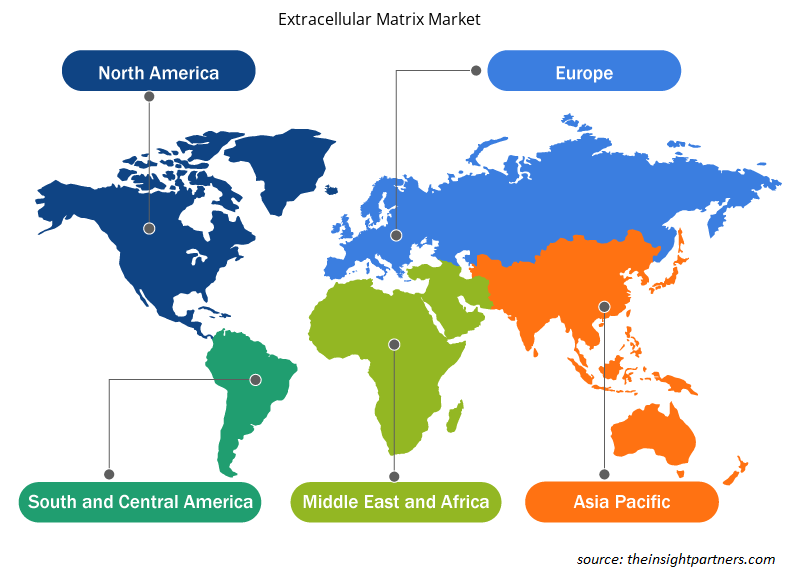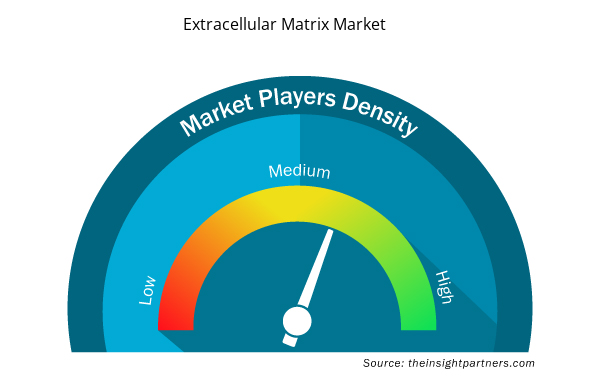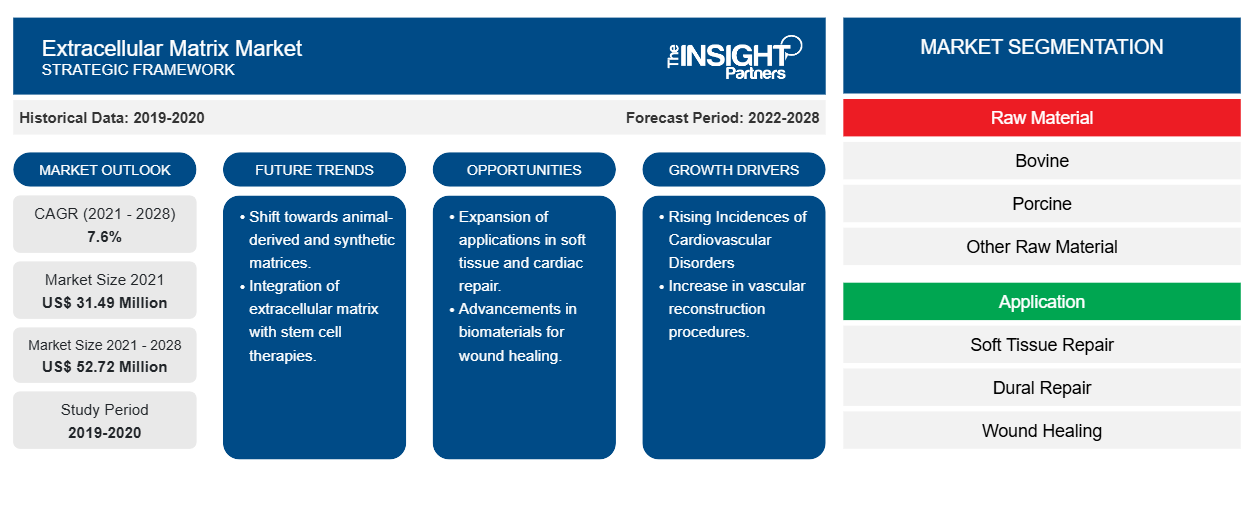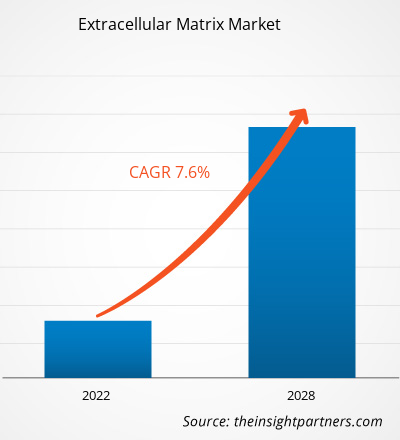Der Markt für extrazelluläre Matrizen soll von 31,49 Millionen US-Dollar im Jahr 2021 auf 52,72 Millionen US-Dollar im Jahr 2028 anwachsen. Von 2021 bis 2028 wird mit einer durchschnittlichen jährlichen Wachstumsrate von 7,6 % gerechnet.
Die extrazelluläre Matrix befindet sich auf der Außenseite des Gewebes und hilft dem Gewebe, die Zellen mit Kollagen zu binden. Sie besteht aus Strukturproteinen, Glykoproteinen, Glykosaminoglykanen und Proteoglykanen. Die extrazelluläre Matrix ermöglicht das Nachwachsen der Empfängerzellen und wird daher in verschiedenen Anwendungen eingesetzt, darunter bei Herz- und Gefäßreparaturverfahren. Mehrere Faktoren, wie die deutlich steigende Inzidenz von Herz-Kreislauf-Erkrankungen und Traumata sowie eine Zunahme von Gefäßrekonstruktionsverfahren, fördern das Wachstum des Marktes für extrazelluläre Matrix . Die Herausforderungen bei der Verwendung der dezellularisierten extrazellulären Matrix hemmen jedoch das Marktwachstum.
Passen Sie diesen Bericht Ihren Anforderungen an
Sie erhalten kostenlose Anpassungen an jedem Bericht, einschließlich Teilen dieses Berichts oder einer Analyse auf Länderebene, eines Excel-Datenpakets sowie tolle Angebote und Rabatte für Start-ups und Universitäten.
- Holen Sie sich die wichtigsten Markttrends aus diesem Bericht.Dieses KOSTENLOSE Beispiel umfasst eine Datenanalyse von Markttrends bis hin zu Schätzungen und Prognosen.
Markteinblicke
Steigende Fälle von Herz-Kreislauf-Erkrankungen und Traumata kurbeln das Wachstum des Marktes für extrazelluläre Matrix an
Der deutliche Anstieg der Fälle orthopädischer Traumata und Herz-Kreislauf-Erkrankungen ist der Hauptfaktor für das Wachstum des globalen Marktes für extrazelluläre Matrix. Als Teil der Behandlung bietet die extrazelluläre Matrix mehrere Vorteile bei der Behandlung verschiedener chronischer Verletzungen, die durch Operationen, Unfälle, chronische Krankheiten und andere Vorfälle verursacht wurden. Darüber hinaus nehmen Herzinsuffizienz und Herzinfarkt in der alternden Bevölkerung zu. Die minimalinvasive Behandlung dieser Herz-Kreislauf-Behandlungsverfahren erfordert eine extrazelluläre Matrix. Bei einem Patienten mit Herzkrankheiten können die funktionellen Eigenschaften des Herzgewebes nicht wiederhergestellt werden. Die Fähigkeit der extrazellulären Matrix, nachzuwachsen und adaptive Reparatur und Regeneration zu fördern, ermöglicht es den Patienten, ihre normalen Funktionen wiederherzustellen. Außerdem hat sie vielversprechende klinische Ergebnisse für das Tissue Engineering bei der Behandlung von Herz-Kreislauf-Erkrankungen und anderen Gesundheitszuständen gezeigt.
Darüber hinaus wird erwartet, dass die steigende Zahl von Herz-Kreislauf-Erkrankungen das Wachstum der extrazellulären Matrix vorantreibt. So starben laut 2019 veröffentlichten WHO-Daten schätzungsweise 17,9 Millionen Menschen an Herz-Kreislauf-Erkrankungen, was 32 % aller weltweiten Todesfälle entspricht. Von diesen Todesfällen waren 85 % auf Herzinfarkt und Schlaganfall zurückzuführen. Laut dem European Cardiovascular Disease Statistics Report von 2017 verursachen Herz-Kreislauf-Erkrankungen (CVD) in Europa jedes Jahr 3,9 Millionen Todesfälle und in der Europäischen Union (EU) über 1,8 Millionen Todesfälle.
Rohstoffbasierte Erkenntnisse
Basierend auf dem Rohmaterial ist der Markt für extrazelluläre Matrix in Rinder-, Schweine- und andere Rohstoffe segmentiert. Das Schweinesegment wird voraussichtlich den größten Marktanteil halten, während das Rindersegment im Prognosezeitraum voraussichtlich die höchste durchschnittliche jährliche Wachstumsrate verzeichnen wird.
Basierend auf der Anwendung wurde der Markt für extrazelluläre Matrix in Weichteilreparatur, Durareparatur , Wundheilung, Herzreparatur, Perikardreparatur sowie Gefäßreparatur und -rekonstruktion segmentiert. Das Segment Weichteilreparatur dürfte im Jahr 2021 einen größeren Marktanteil ausmachen. Es wird jedoch erwartet, dass das Segment Gefäßreparatur und -rekonstruktion im Prognosezeitraum eine höhere durchschnittliche jährliche Wachstumsrate (CAGR) auf dem Markt verzeichnet.
Verschiedene auf dem Markt für extrazelluläre Matrix tätige Unternehmen verfolgen Marketingstrategien wie Produkteinführungen, Fusionen und Übernahmen, Kooperationen, Produktinnovationen und die Erweiterung ihres Produktportfolios, um ihre Präsenz weltweit auszubauen, den Markennamen zu wahren und die steigende Nachfrage der Endbenutzer zu erfüllen.
Regionale Einblicke in den Markt für extrazelluläre Matrix
Die regionalen Trends und Faktoren, die den Markt für extrazelluläre Matrix während des gesamten Prognosezeitraums beeinflussen, wurden von den Analysten von Insight Partners ausführlich erläutert. In diesem Abschnitt werden auch die Marktsegmente und die Geografie für extrazelluläre Matrix in Nordamerika, Europa, im asiatisch-pazifischen Raum, im Nahen Osten und Afrika sowie in Süd- und Mittelamerika erörtert.

- Erhalten Sie regionalspezifische Daten zum Markt für extrazelluläre Matrix
Umfang des Marktberichts zur extrazellulären Matrix
| Berichtsattribut | Details |
|---|---|
| Marktgröße im Jahr 2021 | 31,49 Millionen US-Dollar |
| Marktgröße bis 2028 | 52,72 Millionen US-Dollar |
| Globale CAGR (2021 - 2028) | 7,6 % |
| Historische Daten | 2019-2020 |
| Prognosezeitraum | 2022–2028 |
| Abgedeckte Segmente | Nach Rohmaterial
|
| Abgedeckte Regionen und Länder | Nordamerika
|
| Marktführer und wichtige Unternehmensprofile |
|
Dichte der Marktteilnehmer für extrazelluläre Matrix: Die Auswirkungen auf die Geschäftsdynamik verstehen
Der Markt für extrazelluläre Matrix wächst rasant, angetrieben durch die steigende Nachfrage der Endnutzer aufgrund von Faktoren wie sich entwickelnden Verbraucherpräferenzen, technologischen Fortschritten und einem größeren Bewusstsein für die Vorteile des Produkts. Mit steigender Nachfrage erweitern Unternehmen ihr Angebot, entwickeln Innovationen, um die Bedürfnisse der Verbraucher zu erfüllen, und nutzen neue Trends, was das Marktwachstum weiter ankurbelt.
Die Marktteilnehmerdichte bezieht sich auf die Verteilung der Firmen oder Unternehmen, die in einem bestimmten Markt oder einer bestimmten Branche tätig sind. Sie gibt an, wie viele Wettbewerber (Marktteilnehmer) in einem bestimmten Marktraum im Verhältnis zu seiner Größe oder seinem gesamten Marktwert präsent sind.
Die wichtigsten auf dem Markt für extrazelluläre Matrix tätigen Unternehmen sind:
- Anteris
- Aziyo Biologics, Inc
- Coloplast Gruppe
- Cook Biotech, Inc
- DSM Biomedical
Haftungsausschluss : Die oben aufgeführten Unternehmen sind nicht in einer bestimmten Reihenfolge aufgeführt.

- Überblick über die wichtigsten Akteure auf dem Markt für extrazelluläre Matrix
Firmenprofile
- Anteris
- Aziyo Biologics, Inc
- Coloplast Gruppe
- Cook Biotech, Inc
- DSM Biomedical
- Baxter
- Medtronic
- Merck KGaA
- MTF Biologics
- Smith & Neffe
- Historische Analyse (2 Jahre), Basisjahr, Prognose (7 Jahre) mit CAGR
- PEST- und SWOT-Analyse
- Marktgröße Wert/Volumen – Global, Regional, Land
- Branche und Wettbewerbsumfeld
- Excel-Datensatz



Report Coverage
Revenue forecast, Company Analysis, Industry landscape, Growth factors, and Trends

Segment Covered
This text is related
to segments covered.

Regional Scope
North America, Europe, Asia Pacific, Middle East & Africa, South & Central America

Country Scope
This text is related
to country scope.
Häufig gestellte Fragen
Global extracellular matrix market is segmented by region into North America, Europe, Asia Pacific, Middle East & Africa and South & Central America. In North America, the U.S. is the largest market for sleep apnea diagnostics. The market growth in the country is attributed to the rising prevalence of wounds and injuries. The growth of the market is mainly driven by the significant rise in cardiovascular disorders among the American population. And, Asia Pacific is the fastest-growing region growing at the CAGR of 8.2% during the forecast period.
The extracellular matrix market majorly consists of the players such as Anteris, Aziyo Biologics, Inc., Coloplast Group, Cook Biotech, Inc., DSM Biomedical, Baxter International, Inc., Medtronic, Merck KGaA, MTF Biologics, and Smith & Nephew, among others
The soft tissue repair segment dominated the global extracellular matrix market and accounted for the largest revenue share of 24.11% in 2021.
The Porcine segment dominated the global extracellular matrix market and held the largest revenue share of 43.76% in 2021.
Extracellular matrix is present in the outer side of the tissues and it helps tissues to bind the cells with collagen. It consists of structural proteins, glycoproteins, glycosaminoglycans and proteoglycans. Extracellular matrix enables recipient cells to regrow and thus it is used in various applications which include cardiac and vascular repair procedure.
Key factors that are driving the growth of this market are rising incidence of cardiovascular diseases and trauma along with increase in vascular reconstruction procedures.
Trends and growth analysis reports related to Life Sciences : READ MORE..
The List of Companies - Extracellular Matrix Market
- Anteris
- Aziyo Biologics, Inc
- Coloplast Group
- Cook Biotech, Inc
- DSM Biomedical
- Baxter
- Medtronic
- Merck KGaA
- MTF Biologics
- Smith & Nephew
The Insight Partners performs research in 4 major stages: Data Collection & Secondary Research, Primary Research, Data Analysis and Data Triangulation & Final Review.
- Data Collection and Secondary Research:
As a market research and consulting firm operating from a decade, we have published and advised several client across the globe. First step for any study will start with an assessment of currently available data and insights from existing reports. Further, historical and current market information is collected from Investor Presentations, Annual Reports, SEC Filings, etc., and other information related to company’s performance and market positioning are gathered from Paid Databases (Factiva, Hoovers, and Reuters) and various other publications available in public domain.
Several associations trade associates, technical forums, institutes, societies and organization are accessed to gain technical as well as market related insights through their publications such as research papers, blogs and press releases related to the studies are referred to get cues about the market. Further, white papers, journals, magazines, and other news articles published in last 3 years are scrutinized and analyzed to understand the current market trends.
- Primary Research:
The primarily interview analysis comprise of data obtained from industry participants interview and answers to survey questions gathered by in-house primary team.
For primary research, interviews are conducted with industry experts/CEOs/Marketing Managers/VPs/Subject Matter Experts from both demand and supply side to get a 360-degree view of the market. The primary team conducts several interviews based on the complexity of the markets to understand the various market trends and dynamics which makes research more credible and precise.
A typical research interview fulfils the following functions:
- Provides first-hand information on the market size, market trends, growth trends, competitive landscape, and outlook
- Validates and strengthens in-house secondary research findings
- Develops the analysis team’s expertise and market understanding
Primary research involves email interactions and telephone interviews for each market, category, segment, and sub-segment across geographies. The participants who typically take part in such a process include, but are not limited to:
- Industry participants: VPs, business development managers, market intelligence managers and national sales managers
- Outside experts: Valuation experts, research analysts and key opinion leaders specializing in the electronics and semiconductor industry.
Below is the breakup of our primary respondents by company, designation, and region:

Once we receive the confirmation from primary research sources or primary respondents, we finalize the base year market estimation and forecast the data as per the macroeconomic and microeconomic factors assessed during data collection.
- Data Analysis:
Once data is validated through both secondary as well as primary respondents, we finalize the market estimations by hypothesis formulation and factor analysis at regional and country level.
- Macro-Economic Factor Analysis:
We analyse macroeconomic indicators such the gross domestic product (GDP), increase in the demand for goods and services across industries, technological advancement, regional economic growth, governmental policies, the influence of COVID-19, PEST analysis, and other aspects. This analysis aids in setting benchmarks for various nations/regions and approximating market splits. Additionally, the general trend of the aforementioned components aid in determining the market's development possibilities.
- Country Level Data:
Various factors that are especially aligned to the country are taken into account to determine the market size for a certain area and country, including the presence of vendors, such as headquarters and offices, the country's GDP, demand patterns, and industry growth. To comprehend the market dynamics for the nation, a number of growth variables, inhibitors, application areas, and current market trends are researched. The aforementioned elements aid in determining the country's overall market's growth potential.
- Company Profile:
The “Table of Contents” is formulated by listing and analyzing more than 25 - 30 companies operating in the market ecosystem across geographies. However, we profile only 10 companies as a standard practice in our syndicate reports. These 10 companies comprise leading, emerging, and regional players. Nonetheless, our analysis is not restricted to the 10 listed companies, we also analyze other companies present in the market to develop a holistic view and understand the prevailing trends. The “Company Profiles” section in the report covers key facts, business description, products & services, financial information, SWOT analysis, and key developments. The financial information presented is extracted from the annual reports and official documents of the publicly listed companies. Upon collecting the information for the sections of respective companies, we verify them via various primary sources and then compile the data in respective company profiles. The company level information helps us in deriving the base number as well as in forecasting the market size.
- Developing Base Number:
Aggregation of sales statistics (2020-2022) and macro-economic factor, and other secondary and primary research insights are utilized to arrive at base number and related market shares for 2022. The data gaps are identified in this step and relevant market data is analyzed, collected from paid primary interviews or databases. On finalizing the base year market size, forecasts are developed on the basis of macro-economic, industry and market growth factors and company level analysis.
- Data Triangulation and Final Review:
The market findings and base year market size calculations are validated from supply as well as demand side. Demand side validations are based on macro-economic factor analysis and benchmarks for respective regions and countries. In case of supply side validations, revenues of major companies are estimated (in case not available) based on industry benchmark, approximate number of employees, product portfolio, and primary interviews revenues are gathered. Further revenue from target product/service segment is assessed to avoid overshooting of market statistics. In case of heavy deviations between supply and demand side values, all thes steps are repeated to achieve synchronization.
We follow an iterative model, wherein we share our research findings with Subject Matter Experts (SME’s) and Key Opinion Leaders (KOLs) until consensus view of the market is not formulated – this model negates any drastic deviation in the opinions of experts. Only validated and universally acceptable research findings are quoted in our reports.
We have important check points that we use to validate our research findings – which we call – data triangulation, where we validate the information, we generate from secondary sources with primary interviews and then we re-validate with our internal data bases and Subject matter experts. This comprehensive model enables us to deliver high quality, reliable data in shortest possible time.


 Holen Sie sich ein kostenloses Muster für diesen Bericht
Holen Sie sich ein kostenloses Muster für diesen Bericht